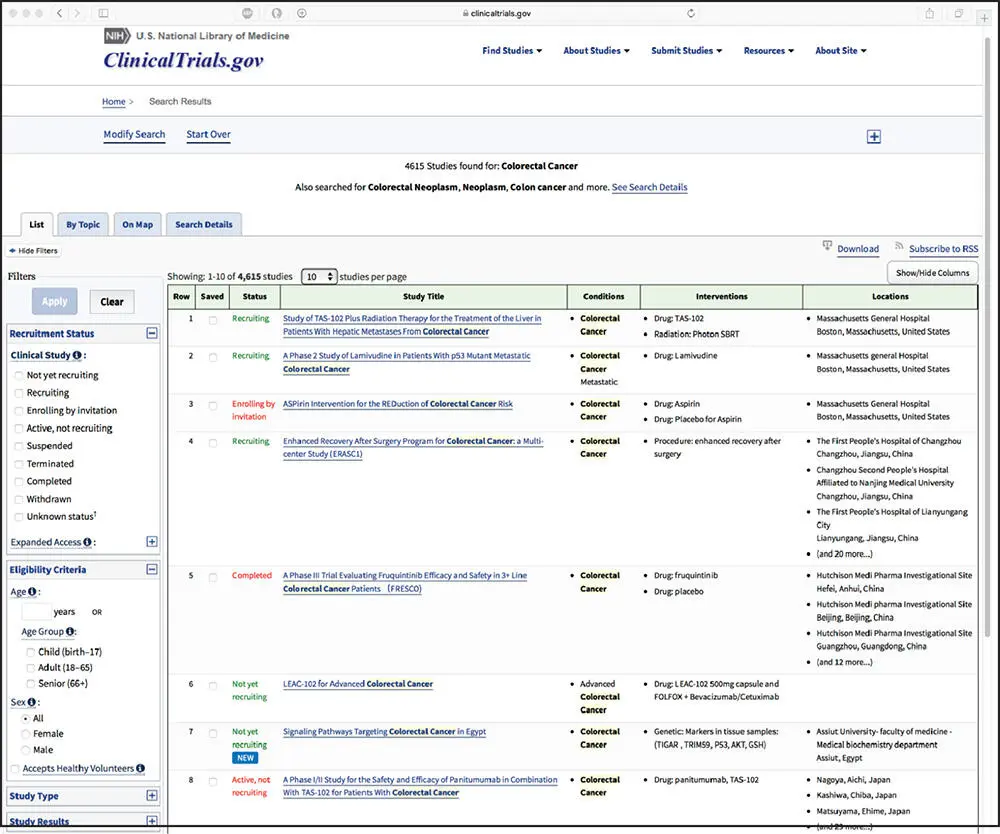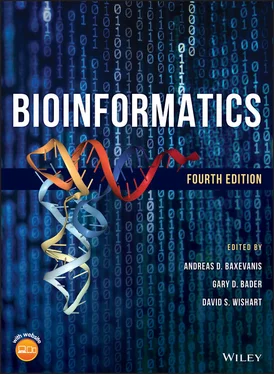Here, we will continue the Entrez example from the previous section, following the OMIM (cited) link found in the Discovery Column shown in Figure 2.3. An intermediate landing page will then appear listing two entries, one for the DCC gene, the other for a phenotype entry describing mirror movements ( Figure 2.13). Clicking on the second entry leads the user to the OMIM page for the DCC gene shown in Figure 2.14, with the Text section of the entry providing a comprehensive overview of seminal details regarding the identification of the gene, its structure, relevant biochemical features, mapping information, an overview of the gene's function and molecular genetics, and studies involving animal models. For individuals starting work on a new gene or genetic disorder, this expertly curated section of the OMIM entry should be considered “required reading,” as it presents the most important aspects of any given gene, with links to the original studies cited within the narrative embedded throughout. A particularly useful feature is the list of allelic variants ( Figure 2.15); a short description is given after each allelic variant of the clinical or biochemical outcome of that particular mutation. At the time of this writing, there are over 5200 OMIM entries containing at least one allelic variant that either causes or is associated with a discrete phenotype in humans. Note that the allelic variants shown in Figure 2.15produce significantly different clinical outcomes – two different types of cancer as well as the motor disorder used throughout this example – an interesting case where different mutations in the same gene lead to distinct genetic disorders.

Figure 2.14 The Online Mendelian Inheritance in Man (OMIM) entry for the DCC gene. Each entry in OMIM includes information such as the gene symbol, alternative names for the disease, a description of the disease, a clinical synopsis, and references. See text for details.
The studies leading to these and similar observations described in a typical entry often provide the foundation for clinical trials aimed at translating this knowledge into new prevention and treatment strategies. NIH's central information source for clinical trials, aptly named ClinicalTrials.gov, contains data on both publicly and privately funded clinical trials being conducted worldwide. Figure 2.16shows the first eight of more than 4600 clinical trials actively recruiting patients with colorectal cancer at the time of this writing, and clicking on the name of a protocol will bring the user to a page providing information on the study, including the principal investigator's name and contact information. Clicking the On Map tab at the top of the page produces a clickable map of the world showing how many clinical trials are being conducted in each region or country ( Figure 2.17); this view is useful in identifying trials that are geographically close to a potential study subject's home. While we, as scientists, tend to focus on the types of information discussed throughout the rest of this chapter, the clinical trials site is, unarguably, the most important of the sites covered in this chapter, as it provides a means through which patients with a given genetic or metabolic disorder can receive the latest, cutting-edge treatment – treatment that may make a substantial difference to their quality of life.

Figure 2.15 An example of a list of allelic variants that can be found through Online Mendelian Inheritance in Man (OMIM). The figure shows three of the four allelic variants for the DCC gene. Two of the documented variants lead to cancers of the digestive tract, while two are associated with a movement disorder. The description under each allelic variant provides information specific to that particular mutation.

Figure 2.16 The ClinicalTrials.govpage showing all actively recruiting clinical trials relating to colorectal neoplasms. Information on each trial, including the principal investigator of the trial and qualification criteria for participating in the trial, can be found by clicking on the name of the trial.
Organismal Sequence Databases Beyond NCBI
Although it may appear from this discussion that NCBI is the center of the sequence universe, many specialized genomic databases throughout the world serve specific groups in the scientific community. Often, these databases provide additional information not available elsewhere, such as phenotypes, experimental conditions, strain crosses, and map features. These data are of great importance to these communities, not only because they influence experimental design and interpretation of experimental results but also because the kinds of data they contain do not always fit neatly within the confines of the NCBI data model. Development of specialized databases necessarily ensued (and continues), and these databases are intended to be used as an important adjunct to GenBank and similar global databases. It is impossible to discuss the wide variety of such value-added databases here but, to emphasize the sheer number of such databases that exist, the journal Nucleic Acids Research devotes its first issue every year to papers describing these databases (Galperin et al. 2017).

Figure 2.17 A clickable map showing where actively recruiting clinical trials relating to colorectal neoplasms are being conducted. This map-based view of the information presented in Figure 2.15is useful in identifying trials that are within a reasonable distance of a potential study participant's home.
An excellent representative example of a specialized organismal database is the Mouse Genome Database (MGD; Bult et al. 2016). Housed at the Jackson Laboratory in Bar Harbor, ME, the MGD provides a curated, comprehensive knowledgebase on the laboratory mouse and is an integral part of its overall Mouse Genome Informatics (MGI) resource. The MGD provides information on genes, genetic markers, mutant alleles and phenotypes, and homologies to other organisms, as well as extensive linkage, cytogenetic, genetic, and physical mapping data. A cross-section of these data is shown in Figure 2.18, providing information on the Dcc gene in mouse, the ortholog to the human DCC gene from the examples discussed earlier in this chapter. This page can be accessed either by directly searching for the gene name or, in this case, by following links found within the Animal Model section of the OMIM entry for DCC discussing seminal discoveries made using mouse models that, in turn, informed our understanding of the effect of DCC mutations in humans.

Figure 2.18 The Mouse Genome Informatics (MGI) entry for the Dcc gene in mouse. The entry provides information on the ortholog to the human DCC gene, including data on mutant alleles and phenotypes, mapping data, single-nucleotide polymorphisms, and expression data. In the Mutations, Alleles, and Phenotypes section, the phenotype overview uses blue squares to indicate which phenotypes are due to mutations in the Dcc gene. In the Expression section, blue squares indicate expression in wild-type mice in the designated tissues, organs, or systems.
Читать дальше









